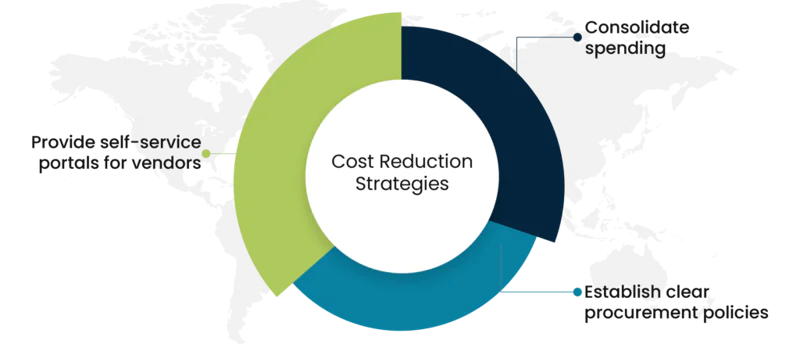Key Takeaways
- Enhanced Cost Savings: Effective procurement analysis and spend optimization can significantly reduce costs and improve profitability for procurement organizations.
- Strategic Decision-Making: Utilizing procurement analytics, cost-benefit analysis, and life cycle costing enables well-informed, strategic purchasing decisions that align with organizational goals.
- Improved Efficiency: Leveraging time-efficient procurement practices and detailed spend analysis helps streamline the P2P cycle and enhance overall procurement process efficiency.
- Strengthened Supplier Relationships: Comprehensive procurement practices, including target costing and cost-effectiveness analysis, facilitate better supplier relationships and ensure compliance with spending rules.
Procurement is much more than just a purchase function. Procurement is a process of finding, negotiating prices and terms, and acquiring goods and services from an external party i.e. a supplier. Procurement analysis entails identifying cost-saving opportunities, driving profitability, ensuring the purchase strategies are in sync with the business objectives, and maintaining optimum inventory levels in the organization. It analyzes the supplier’s pricing strategy, delivery times, and maverick spending and drives effective supplier relationship management.
Procurement analysis is essential for any organization irrespective of its size or the revenue it generates. With the expansion of business, the organizational complexity also increases, this demands an effective procurement analysis in place to offer actionable insights and facilitate well-informed decision-making.
Procurement Cost Analysis – Why Does Your Organization Need it?
Procurement professionals believe that procurement cost analysis is essential for every organization regardless of its size, structure, and complexity. It is also essential to conduct it at regular intervals so as to make sure that the organization is investing its money in the right place. Often organizations hold excess inventory resulting in working capital being held captive. They also pay a higher price in order to procure goods and services. If only the procurement function analyses its cost components and cost drives, it can drive cost savings in the organization. Performing a procurement analysis helps the organization identify costs, determine optimum inventory levels, manage supplier relations and understand their pricing strategies, establish acceptable delivery time, and eliminate maverick spending.
- It helps in determining the total costs of acquiring goods and services from an external supplier which includes delivery charges, handling, and warehouse costs.
- It helps procurement professionals in defining optimum inventory levels, analyzing the costs of handling and storing the goods, and evaluating their opportunity costs.
- This also enables effective supplier relationship management, understanding the supplier activities and pricing strategy, identifying the suppliers that add value to the organization, and facilitating the procurement professionals in negotiating terms and conditions with the suppliers.
- Maverick’s spending is not good for the organization’s health and profitability. Procurement analysis identifies and analyses purchase requests and invoices so as to identify the maverick spending that could have been avoided.
Benefits of an Effective Procurement Cost Analysis
A procurement cost analysis provides detailed insights to the management who can further formulate strategies to drive organizational growth. The three benefits of a procurement analysis are as follows: first, it drives profitability by identifying cost-saving opportunities. Secondly, continuous improvement and value addition take place since the organization is aware of the latest developments and trends in the industry. This helps the procurement function to measure the actual performance with the standard performance and take corrective actions. Lastly, it improves the credibility of the procurement function and motivates it to identify the KPIs that drive cost savings opportunities. An effective procurement analysis guarantees the involvement of the procurement function while developing a new product strategy thereby working in tandem with the other departments in the organization.
At SpendEdge, we offer granular insights that help organizations identify cost-saving opportunities, determine the factors that drive profitability, and make well-informed strategic decisions. Our wide range of supply market intelligence services and supply chain risk assessment solutions assist our clients in identifying potential procurement pain points and solutions to mitigate potential risks.
Procurement cost reduction strategies that can benefit businesses

Provide self-service portals for vendors:
Vendor portals have the potential to improve environmental sustainability by eliminating paper usage. They can also significantly reduce data entry errors and offer additional services that can effectively reduce the workload on accounts payable staff. Moreover, they can help ensure compliance with vendor onboarding procedures, capture a higher percentage of early payment discounts, mitigate the risk of supply chain disruptions or supplier fraud, and improve supplier satisfaction worldwide.
Consolidate spending:
Consolidating vendors can bring several benefits to your business operations. This includes reducing costs by taking advantage of purchasing power and accessing better prices, discounts, and terms. Additionally, vendor consolidation can help you save on administrative and transactional expenses such as invoices, audits, and contracts.
Establish clear procurement policies:
It is important to create well-defined procurement policies that outline the procedures and guidelines for purchasing goods and services. These policies should be clear, concise, and easy to understand for all stakeholders involved in the procurement process. A well-designed procurement policy can help to ensure that purchasing decisions are made in a transparent, fair, and efficient manner, leading to better outcomes for the organization.
To know more about procurement analysis and supply market intelligence

Conclusion
In today’s complex business environment, procurement organizations must go beyond traditional purchasing practices to optimize the P2P cycle and achieve significant cost savings. Procurement analysis plays a crucial role in this transformation by leveraging procurement analytics to enhance time efficiency and identify opportunities for spend optimization. Through detailed spend analytics and spend analysis, organizations can establish effective spending rules, conduct thorough cost analysis, and implement cost-benefit analysis and cost-effectiveness analysis. These practices, including life cycle costing and target costing, ensure that procurement decisions are strategically aligned with organizational goals. By adopting these advanced procurement strategies, businesses can drive profitability, improve supplier relationships, and achieve sustainable growth.




